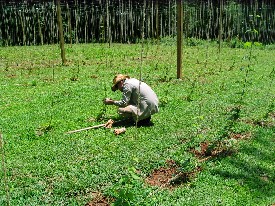Hot Crops: What Are Farmers Asking About?
go.ncsu.edu/readext?436125
en Español / em Português
El inglés es el idioma de control de esta página. En la medida en que haya algún conflicto entre la traducción al inglés y la traducción, el inglés prevalece.
Al hacer clic en el enlace de traducción se activa un servicio de traducción gratuito para convertir la página al español. Al igual que con cualquier traducción por Internet, la conversión no es sensible al contexto y puede que no traduzca el texto en su significado original. NC State Extension no garantiza la exactitud del texto traducido. Por favor, tenga en cuenta que algunas aplicaciones y/o servicios pueden no funcionar como se espera cuando se traducen.
Português
Inglês é o idioma de controle desta página. Na medida que haja algum conflito entre o texto original em Inglês e a tradução, o Inglês prevalece.
Ao clicar no link de tradução, um serviço gratuito de tradução será ativado para converter a página para o Português. Como em qualquer tradução pela internet, a conversão não é sensivel ao contexto e pode não ocorrer a tradução para o significado orginal. O serviço de Extensão da Carolina do Norte (NC State Extension) não garante a exatidão do texto traduzido. Por favor, observe que algumas funções ou serviços podem não funcionar como esperado após a tradução.
English
English is the controlling language of this page. To the extent there is any conflict between the English text and the translation, English controls.
Clicking on the translation link activates a free translation service to convert the page to Spanish. As with any Internet translation, the conversion is not context-sensitive and may not translate the text to its original meaning. NC State Extension does not guarantee the accuracy of the translated text. Please note that some applications and/or services may not function as expected when translated.
Collapse ▲Hops, An Up and Coming Crop in North Carolina
- Field Guide for Integrated Pest Management in Hops – PDF – Produced by Oregon State University, University of Idaho, USDA – Agricultural Research Service, and Washington State University
Can I grow olives commercially in North Carolina?
Olives are a Mediterranean crop, and U.S. production is mostly in California. The most popular commercial varieties probably will not thrive in our environment. However, there are several individuals across the state who have a few olive trees that seem to do very well. They are located in the piedmont. So, it’s not that olives won’t grow at all in North Carolina, they probably just won’t do well enough to get the yields and quality to be competitive with the big production areas. If someone really wants to try growing some olives, I would suggest researching all the varieties that are available and ordering a few of the ones that look like they have the best chance of surviving in our area. These might not be the highest yielding varieties, but to start we just want them to survive and produce olives. Most olives, even the hardiest, will probably not make it through the winter if it gets below 12 degrees F. But, if someone could even get small yields from the trees, there are niche market opportunities for them, such as fresh market sales to upscale restaurants and natural food stores who cater to the buy local customer. And the grower could make value-added products such as specialty packed olives and boutique oils. Those could be sold, for example, to local wineries for cross-mechanizing with local wines.
To get more information on olives, go to:
- University of California at Davis Olive Center
- Texas Extension Olive Production Guide
- Texas Association of Olive Oil (TXAOO)
Jeanine Davis, NC Alternative Crops & Organics Program, Department of Horticultural Science, NC State University (reviewed and updated 5/12/2023).



